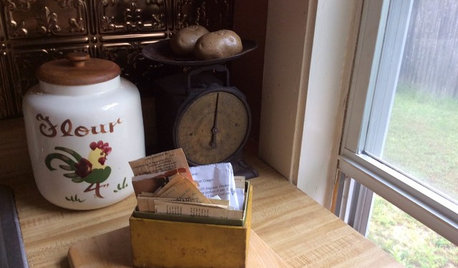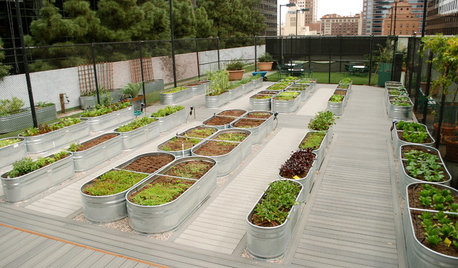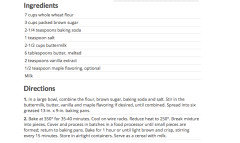Old fashioned breakfast cereal recipe please
kumquatlady
12 years ago
Featured Answer
Comments (32)
slowlane
12 years agolast modified: 9 years agograinlady_ks
12 years agolast modified: 9 years agoRelated Discussions
old fashioned red cabbage-recipe anyone?
Comments (7)This one is very good and has been repeated several times here on the forum: BRAISED SWEET AND SOUR RED CABBAGE Serves 4 - 6 1 TBS olive oil 1 onion, sliced 1 large apple, cored and chopped 1 small red cabbage, quartered, cored and thinly shredded - (6 cups shredded) 1 full cup (9 fl oz) apple juice (250 ml) 3 TBS balsamic vinegar 1 TBS sugar substitute 1 teasp sea salt 1/2 teasp freshly ground black pepper 1. Heat the olive oil over a medium-high heat in a deep frying pan. Cook the onion and apple for 5 minutes or until softened. Stir in the cabbage and toss well. Add the apple juice, vinegar, sugar substitute and seasoning and stir. 2. Reduce the heat and simmer, covered, for 30 minutes or until the liquid reduces completely and the cabbage is tender. Check seasoning and serve. Leftovers can be chilled for one day and reheated over a moderate heat. Source: Adapted from Rick Gallop's GI Diet Green-Light Cookbook My Comments: This is a really good, tangy side dish for those who love red cabbage! I halved the recipe for just the two of us but it was so good we nearly finished it all, so no problem with making too much. When finely shredded  with a mandolin - the cabbage measured exactly 3 cups (200 grams) for my halved version. I used one small apple and half an onion but didnÂt reduce the olive oil. Wolf was very pleased with this dish ! SharonCb...See MoreRECIPE: aunt lo dees old fashioned pralines
Comments (1)I'll bet they'd still be good if you cheated and ate them early before they were completely dry! I love pralines....See MoreOld-fashioned Ginger Beer Recipe
Comments (4)OMM Thanks so much for taking the time to post this recipe. It sounds really refreshing. The plastic bottles are an excellent idea. I'm going to try a batch as soon as I can get to the brew shop and get some beer yeast....See Moreupdate to my 'old fashioned' post
Comments (7)thank you all for the kind words. It has been less stressful. DD and I attended a baby shower (or Baby Sprinkle the invite said, whatever that means haha), and she had another set of g.parents babysit. Seems out of four sets of grandparents for these boys, two are very lenient, let'em run wild types, and my ex and his SO are a little more like me and DH. I so agree with socks and Marilyn... children need rules, it does make them feel safe. She is going back to her friends tomorrow, which will give us a break, what with the heart cath and whatever else in store for DH next week. As Georgysmom says, she will one of these days realize that discipline (which is different from harsh punishment) and rules will make HER life easier. I am hoping I can initiate some small things, like bedtime rituals, and meal times where the family sits together, and then maybe the children will come to expect that. Sorry, I tend to ramble. Just wanted to thank you all. I so appreciate all the caring people here at KT....See Morebejay9_10
12 years agolast modified: 9 years agograinlady_ks
12 years agolast modified: 9 years agoJohanna Abate
3 years agoLars
3 years agofoodonastump
3 years agolast modified: 3 years agoCA Kate z9
3 years agoLars
3 years agolast modified: 3 years agofoodonastump
3 years agobbstx
3 years agofoodonastump
3 years agobbstx
3 years agofoodonastump
3 years agolast modified: 3 years agocolleenoz
3 years agoseagrass_gw Cape Cod
3 years agolindac92
3 years agobbstx
3 years agoSherry8aNorthAL
3 years agolast modified: 3 years agobbstx
3 years agoSherry8aNorthAL
3 years agoSherry8aNorthAL
3 years agolast modified: 3 years agoWalnutCreek Zone 7b/8a
3 years agoLars
3 years agoWalnutCreek Zone 7b/8a
3 years agoannie1992
3 years agoLars
3 years agoWalnutCreek Zone 7b/8a
3 years agobcskye
3 years agoLars
3 years agobragu_DSM 5
3 years ago
Related Stories

KITCHEN DESIGNKitchen Recipes: Secret Ingredients of 5 One-of-a-Kind Cooking Spaces
Learn what went into these cooks’ kitchens — and what comes out of them
Full Story
KITCHEN DESIGN5 Home Cooks Share Their Favorite Family Recipes
Peek inside the kitchens of these Houzz users and learn how to cook their time-tested, passed-down dishes
Full Story
DECORATING GUIDES10 Recipes for Shabby Chic Style
Rustic furniture, floral fabrics, sparkling chandeliers. Here are 10 easy ways to bring the romantic cottage look into your home
Full Story
LANDSCAPE DESIGNRecipe for Modernist Edible Garden Style
Herbs, vegetables and fruit trees aren’t just for traditional gardens. Here’s how to design them into modernist landscapes
Full Story
PRODUCT PICKSGuest Picks: Outfit Your Home in Fab Fashion Designer Accents
You don their clothes to look chic. Now your home can have its turn, with decor from some of the world's greatest fashion houses
Full Story
MY HOUZZMy Houzz: Fashionably Simple in a Williamsburg Apartment
Light and airy rooms, exposed brick and angular mirrors reflect this Brooklyn designer’s modern minimalist style
Full Story
LIFESimple Pleasures: A Real Sit-Down Breakfast
Give grab-and-go the heave-ho. To start the day right, treat yourself to a proper breakfast in a cheery spot
Full Story
KITCHEN DESIGN19 Ways to Create a Cozy Breakfast Nook
No rude awakenings here. Start your day the gentle way, with a snuggly corner for noshing
Full Story
BUDGET DECORATINGBudget Decorator: 8 Ways to Make Old Furniture Look Brand New
Learn stripping, staining, painting and reupholstering basics to make bargain-basement furniture worthy of center stage at home
Full StorySponsored
Your Custom Bath Designers & Remodelers in Columbus I 10X Best Houzz








sweet_betsy No AL Z7